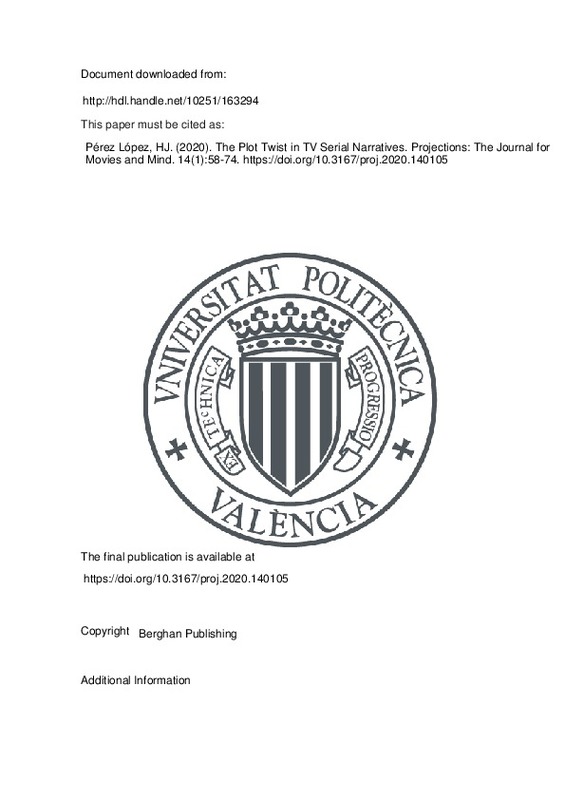JavaScript is disabled for your browser. Some features of this site may not work without it.
Buscar en RiuNet
Listar
Mi cuenta
Estadísticas
Ayuda RiuNet
Admin. UPV
The Plot Twist in TV Serial Narratives
Mostrar el registro sencillo del ítem
Ficheros en el ítem
| dc.contributor.author | Pérez López, Héctor Julio
|
es_ES |
| dc.date.accessioned | 2021-03-06T04:32:11Z | |
| dc.date.available | 2021-03-06T04:32:11Z | |
| dc.date.issued | 2020-03 | es_ES |
| dc.identifier.issn | 1934-9688 | es_ES |
| dc.identifier.uri | http://hdl.handle.net/10251/163294 | |
| dc.description.abstract | [EN] This article explores the use ofthe plot twist in screen fictions.This is a largely unexplored area, as interest in this phenomenon has largely focused on the so-called "plot twist movie," which is an older narrative tradition. In order to explain this aesthetic phenomenon, it draws on the model of surprise originally proposed by the cognitive psychologists Wulf Meyer, Rainer Reisenzein, and Achim Schutzwohl. Plot twists are characterized by three distinct but intimately intertwined temporal segments and their corresponding functions, which are explained by this model. The objective of this article is to explore how cognitive -emotional interactions shape the aestheticviewing experience and to identify how that experience relates to shows' artistic qualities. Game of Thrones (Sol and 503), Homeland (Sol), and Westworld (Sol) will be used as test cases. In each of the three plot segments, there are specific processes that distinguish the experience of surprise as an aesthetic phenomenon. | es_ES |
| dc.description.sponsorship | This article has undergone various phases of improvement, and I owe a lot to various colleagues who have helped me substantially with its development. First of all, my thanks to Rainer Reisenzein for his many readings and reviews of the article. I am also very grateful for the excellent work of the editors of this journal and the detailed suggestions I have received from the reviewers. I would like to acknowledge the contributions of all those colleagues who have provided me with feedback at different academic events where I have presented this research, especially the 2016 SCSMI Conference at Cornell University. Finally, I am very grateful to Martin Boyd for his work to improve the quality of the English of this article. This research was supported by The Secretary of State of Research, Development and Innovation (Ministry of Economy and Competitiveness, Spain) [Research Projects: Theoretical Innovation Strategies in the Analysis of Narration in Television Series CSO2014-51872-R; Interactions Between Cognitive Value and Aesthetic Properties in Contemporary Serials RTI2018-096596-B-I00.] | es_ES |
| dc.language | Inglés | es_ES |
| dc.publisher | Berghan Publishing | es_ES |
| dc.relation.ispartof | Projections: The Journal for Movies and Mind | es_ES |
| dc.rights | Reserva de todos los derechos | es_ES |
| dc.subject | Aesthetic experience | es_ES |
| dc.subject | Multiplot structure | es_ES |
| dc.subject | Plot twist | es_ES |
| dc.subject | Surprise | es_ES |
| dc.subject | Temporal prolongation | es_ES |
| dc.subject | TV serials | es_ES |
| dc.subject.classification | COMUNICACION AUDIOVISUAL Y PUBLICIDAD | es_ES |
| dc.title | The Plot Twist in TV Serial Narratives | es_ES |
| dc.type | Artículo | es_ES |
| dc.identifier.doi | 10.3167/proj.2020.140105 | es_ES |
| dc.relation.projectID | info:eu-repo/grantAgreement/MINECO//CSO2014-51872-R/ES/ESTRATEGIAS DE INNOVACION TEORICA EN EL ANALISIS DE LA NARRACION SERIAL AUDIOVISUAL/ | es_ES |
| dc.relation.projectID | info:eu-repo/grantAgreement/AEI/Plan Estatal de Investigación Científica y Técnica y de Innovación 2017-2020/RTI2018-096596-B-I00/ES/INTERACCIONES ENTRE VALOR COGNITIVO Y PROPIEDADES ESTETICAS EN LA SERIALIDAD CONTEMPORANEA/ | es_ES |
| dc.rights.accessRights | Abierto | es_ES |
| dc.contributor.affiliation | Universitat Politècnica de València. Departamento de Comunicación Audiovisual, Documentación e Historia del Arte - Departament de Comunicació Audiovisual, Documentació i Història de l'Art | es_ES |
| dc.description.bibliographicCitation | Pérez López, HJ. (2020). The Plot Twist in TV Serial Narratives. Projections: The Journal for Movies and Mind. 14(1):58-74. https://doi.org/10.3167/proj.2020.140105 | es_ES |
| dc.description.accrualMethod | S | es_ES |
| dc.relation.publisherversion | https://doi.org/10.3167/proj.2020.140105 | es_ES |
| dc.description.upvformatpinicio | 58 | es_ES |
| dc.description.upvformatpfin | 74 | es_ES |
| dc.type.version | info:eu-repo/semantics/publishedVersion | es_ES |
| dc.description.volume | 14 | es_ES |
| dc.description.issue | 1 | es_ES |
| dc.subject.asignatura | Análisis de series de tv 10215 / Q - Grado en comunicación audiovisual 141 | es_ES |
| dc.subject.asignatura | La narración en la postproducción 32092 / Q - Máster universitario en postproducción digital 2140 | es_ES |
| dc.subject.asignatura | La narración en la postproducción 32092 / Q - Máster universitario en postproducción digital 2154 | es_ES |
| dc.subject.asignatura | La narración en la postproducción 32092 / W - Programa de doctorado en las industrias culturales y de la comunicación 2079 | es_ES |
| dc.relation.pasarela | S\428922 | es_ES |
| dc.contributor.funder | Agencia Estatal de Investigación | es_ES |
| dc.contributor.funder | Ministerio de Economía y Empresa | es_ES |







![[Cerrado]](/themes/UPV/images/candado.png)

